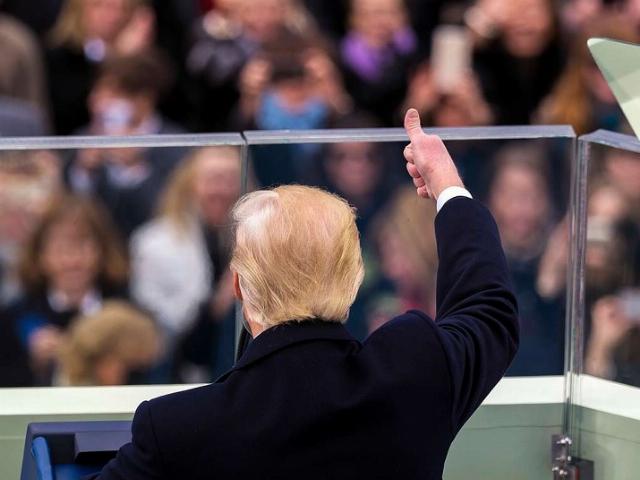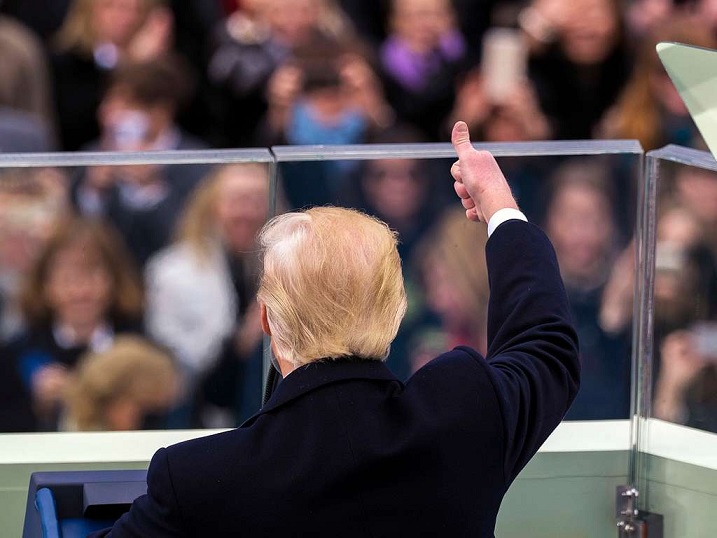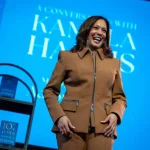

Defense Visual Information Distribution Service
Donald Trump has realigned the Republican party's base and correspondingly reshaped the Democratic party's traditional core.Donald Trump has realigned the Republican party’s base and correspondingly reshaped the Democratic party’s traditional core. Of course, the full extent — and the efficacy — of his reshuffling the two parties’ electoral structures will only be fully seen next week. But even today anyone can see that Vice President Harris is campaigning oblivious to this sea change in the electorate.
The Harris campaign has been hosting events with NeverTrumper establishment Republicans, D.C. insiders, and ridiculously rich celebrities who stoke unfounded fears over Trump’s supposed uncapped volatility, authoritarianism, and dangerousness to women’s medical freedoms. These endorsements are designed to prove the Vice-President’s centrism, especially with suburban women voters, and the purportedly estranging extremism of her opponent, especially to suburban women voters. Regardless of the genuineness of these conversions, peeling off these erstwhile GOP sachems — many of whom Trump forced out of the party or were once despised by Democrats — are not moving the needle in public polling.
Once, affluent suburban country club voters tended to vote their financial self-interests and favored conservative Republican candidates. The GOP’s presidential nominees were usually well known, decorous gentlemen dripping with foreign policy credentials and moral rectitude. These boring candidates famously waited in line for their turn to run and then ran boring campaigns nearly identical to the previous nominee’s.
Conversely, the bedrock of the Democratic electoral strength over the past half a century was broadly in the middle-class. Party apparatchiks demanded its rank-and-file base their votes on age cohort, socio-economic standing, and race. Blue-collar households, of which there were then many, grudgingly supported a host of liberal policies because Democratic candidates promised them well-paying jobs and financial security with nothing more than a high-school education — all so long as these voters roundly rejected out-of-touch GOP candidates running from affluent bubbles. In self-righteous screeds such as 2004’s What’s the Matter with Kansas? liberal intellectuals scorned voters in “flyover” parts of the country who refused to vote their pocketbooks instead of unsubstantial cultural issues.
But that was then — before Trump.
The Democratic party now represents the nation’s affluent and is run largely for those who have become wealthy through embarrassingly lucrative employment in government and NGOs, consulting, big finance, high-tech, and other professions necessitating advanced degrees. White collar, double-income Democrat families have grown richer from public policies that have degraded and rendered prohibitively costly our once superior secondary education system, shipped good paying manufacturing jobs overseas, and, most recently, shut down huge sectors of the real economy while simultaneously growing profits in the digital industry.
During this timeframe, job creation in the non-upper-class sectors of the economy has cratered. In the past few years, any anemic employment growth realized has primarily favored non-citizens and related public sector fields settling these immigrants. And during the current presidential administration especially, the economic ills stemming from chronically disproportionate imbalance in income growth has been compounded by inflation mushrooming at rates not known for decades.
<img alt captext="Defense Visual Information Distribution Service” class=”post-image-right” src=”https://conservativenewsbriefing.com/wp-content/uploads/2024/11/trumps-middle-class-realignment.jpg” width=”450″>In next week’s election, nevertheless, the Harris campaign will still be asking middle-class voters to rally in favor of “reproductive rights,” LGBTQ progress, climate change, essentially open borders, political decorum, and so-called “saving democracy.” The Democratic party leadership will ask these same voters to disregard the fact that many of those same policies have decimated their well-paying jobs, exposed them and their families to violent crime, and disastrously heightened the cost of living more than any period in the past forty years. Even more astonishingly, the Harris campaign will make this political “ask” despite the fact these policies have done far more tangible harm to these financially precarious Democratic voters.
The economically advantaged suffer the financial and emotional stressors of inflation and the affiliated contractions in the economy much less acutely than lower socio-economic classes. Those living in lower-income communities are closer in proximity to the violence and social dysfunction consistently besetting big cities and that coarsen and endanger their lives. Likewise, the hardships that invariably flow from accommodating uncontrolled immigration are generally experienced less significantly by the upper class, whose members may even view cheap labor which does not threaten their professional-type livelihoods as a boon. With a clearer pathway to achieving their material needs, the financial elites are at greater liberty to predicate their votes on vindicating women’s nationwide unrestricted access to abortion and fertility treatments, spurious allegations of fascistic proclivities in conservative office seekers, or simply to fiercely signal their own peculiar ideas of civic virtue and their “oh so righteous” anger against Trump.
Conversely, middle-class voters have found themselves priced out of housing, automobile, and insurance markets like never before. It has become increasingly difficult for Americans without an advanced degree to maintain the same economic lifestyle as their parents and grandparents enjoyed. Additionally, black and Hispanic voters in blue-collar households are at heart conservative on most social and economic issues which do not touch upon their race and more vulnerable to economic downturns. In short, all hard-pressed working people in this country, especially the young men in those communities, have been discovering the painful downsides of backing extravagant liberal policies of a political organization that now predominantly represents not their interests, but those of the bicoastal privileged.
Is it any wonder that that the once loyal middle-class voter feels doubly abandoned by the Democrat party?
Donald Trump speaks to these abandoned middle-class voters. The former President is building a formidable coalition of white, black, and brown voters living in less affluent communities. Trump’s most significant political accomplishment in this election may very well be reducing the class, youth, and racial gap in the Republican vote to levels not seen since the 1960s. Undoubtedly, Trump’s campaign rhetoric, record, and policy positions have affronted more affluent, formerly conservative voters and led to a pronounced gender gap. But this is what an immense massive political realignment, or at least this particular realignment, looks like. Judging from recent national and swing state polling, however, the number of establishment Republicans flocking to Harris’s banner are being offset by Trump’s inroads with traditionally Democratic voting subsets in working-class communities who are increasingly distressed by their more authentic financial struggles and threats to their personal well-being.
The Harris campaign’s high-risk gamble is that these polls may be unreliable insofar as they markedly underestimate a larger than expected turnout from staid conservatives who were once reliably Republican and/or irate women voters. On the other hand, it seems just as likely at this point that the Democrats’ fervently hoped-for intensity in their new voting bloc will be counterbalanced by lower levels of support from an outsized number of average American voters on whom they have customarily depended to win previous elections. Not nearly so outraged by Trump’s occasional blustering because they cannot afford to be, those formerly faithful working-class voters are increasingly less inclined to cast a ballot for the nominee of an increasingly oligarchic Democratic party that has shown itself profoundly indifferent to the crushing difficulties they face daily.
However, dropping endorsements from well-heeled former Republicans and politicking on saving democracy won’t do much at all to recapture that segment of the Democrats’ base that has drifted away and moved towards Trump’s new GOP. Or put another way, Harris and the Democratic party are not trying to treat the fever in the newly realigned body politic, they are campaigning as if this partisan realignment was itself the sole cure.





